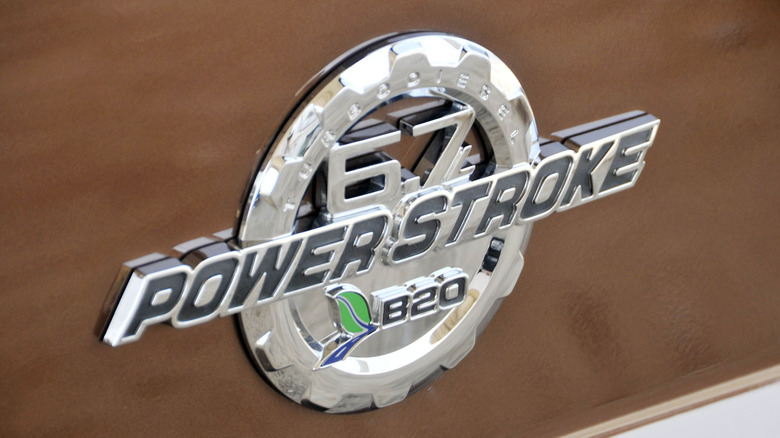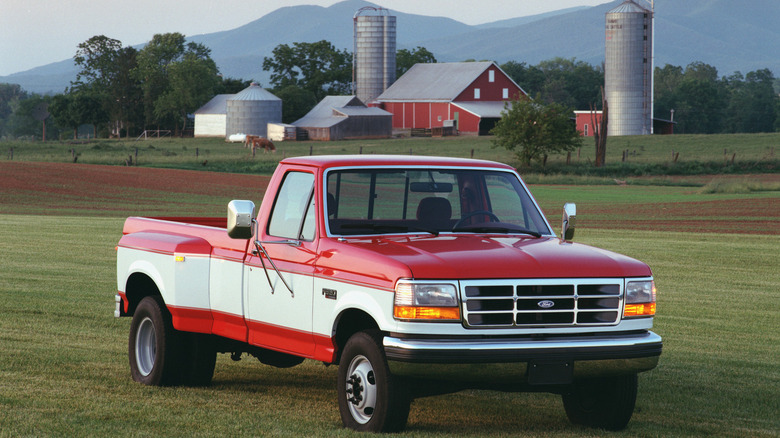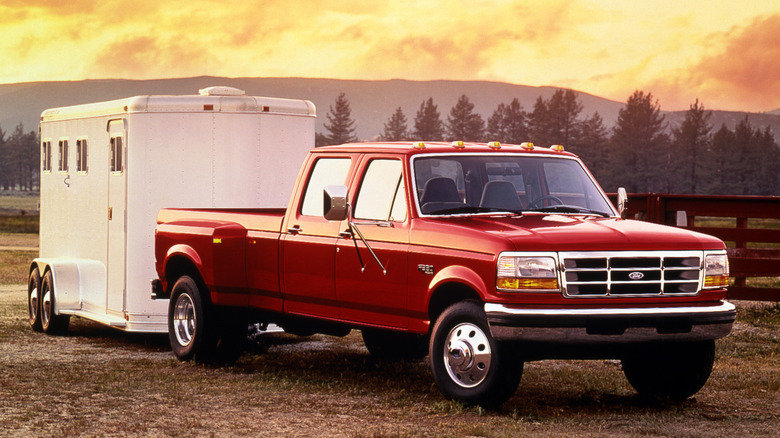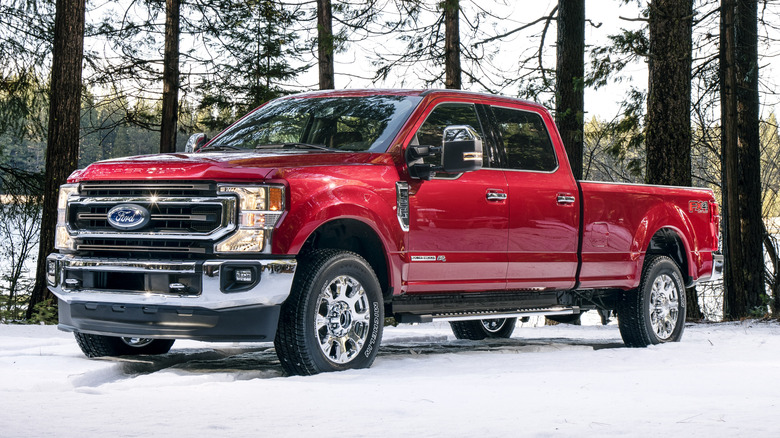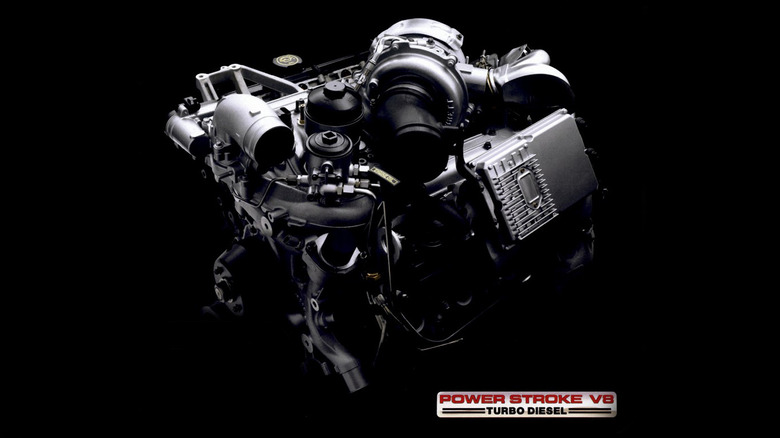The Most Reliable Ford Power Stroke Diesels Ever Made
For diesel engines, the Big Three American truck makers give you three options, Duramax for trucks from General Motors, Cummins engines in Ram trucks, and Power Stroke engines for Ford. Specifically, Power Strokes are fairly well regarded as being reliable and powerful engines, though you may not hear that from a Duramax or Ram fan.
Despite its prominent place within the pantheon of famous Ford powerplants, right next to the Coyote and Ford 5.0, and the fact that diesel-powered Fords have been around for several decades, the "Power Stroke" name itself only dates back to 1994, when it was offered as an optional powerplant for Ford F-250, F-350, Super Duty trucks, and E-Series Econoline vans. The rest, as the cliché says, is history.
Nearly 30 years of diesel history have not been for naught and Ford fans clearly have an affinity for the Power Stroke, even coming up with the rhyme "Hear the whistle, see the smoke, you just got passed by a Power Stroke." But out of the engine line's fairly short history, which big smoke-spewing diesel reigns supreme?
The original Power Stroke
No conversation about Power Strokes (or turbodiesels for that matter) is complete without mentioning the venerable 7.3-liter V8, the engine that started it all and is inarguably the best out of the bunch. Ford pulled out all of the stops when debuting its new engine halfway through 1994, even claiming it was "the biggest, most powerful V-8 diesel available in light trucks." That's quite a claim. Ford even backed it up with a 100,000-mile, five-year warranty (the same diesel warranty applies to new Power Strokes too).
According to Ford, early 7.3 Power Strokes were found after testing to eclipse the 200,000-mile mark with nothing more than regular preventative maintenance and very few major repairs. The serpentine belt itself was designed to last over 100,000 miles. Every bit of the engine from the camshaft down to the piston rings was designed for longevity and pain-free maintenance. People had to rely on their 7.3s to perform as best as possible with minimal downtime, whether that was on the job site, towing a boat, or driving around a farm.
If you don't take Ford at its word, Power Stroke forums sing the engine's praises all day long, and it's not at all unusual to see 7.3-equipped Fords go over 300,000 or even 400,000 miles. It was made from 1994 to 2003 meaning that there are several hundred thousand on the road still rumbling away to this day.
The biggest and the best
The 7.3's power ratings seem almost quaint compared to today's nearly four-digit torque figures from modern diesels. But it was a big deal in the 1990s. During the first year of production, the 7.3 made 210 horsepower and 425 pound-feet of torque. The 5.9-liter Cummins engine in a Dodge Ram from the time made more horsepower and torque when 1995 rolled around, but Ford still had a bigger motor, and that counts for something when huge American trucks are involved.
With the 7.3, Ford also managed to create an entirely new subset of diesel culture that's only rivaled by the aforementioned Cummins engine found in Dodges. Go to any car show in rural America and you are bound to see Power Stroke shirts, hats, and decals. Ford fans now had an extremely competent and well-regarded engine to argue about online and tout the superlatives of.
Decades of diesels
Ford's current turbodiesel engine, the 6.7-liter Power Stroke that you'll find in the Super Duty, came to be in 2011 and is likely the most common Power Stroke you'll see on roads today as it's the only diesel engine choice in Ford's 2023 lineup for the United States.
Compared to the relatively short production runs of previous Power Strokes, the contemporary 6.7-liter diesel you can get in a new Ford is practically ancient. But it certainly isn't lacking in power as a current High-Output 6.7-liter Power Stroke turbodiesel makes 500 horsepower and 1,200 pound-feet of torque. That's frankly obscene. Because it's been in continuous production for over a decade, there's a wide variety of extra components available in both junkyards and auto parts stores. It's by far the best choice for a more modern Power Stroke. It has been reported by The Drive that a 6.7 Power Stroke even reached well over one million miles (albeit with a lot of maintenance and repairs).
That said, the Power Stroke king has to be the original 7.3. It has been nearly three decades since its introduction and there are still plenty of surviving examples, ready to go to work. Newer models may have more bells, whistles, and overall power, but you can't beat old-fashioned dead simple construction and reliability.
The worst Power Strokes
Between 2003 and 2011 there were two additional diesel history hopefuls. Those engines would be the 6-liter and 6.4-liter Power Strokes. Why did Ford, the company that made the 4.9-liter engine for over 30 years, go through two engines in barely eight years? Well, according to MotorTrend, the engines were more useful as boat anchors or money incinerators.
Next to the smash hit that was the 7.3 and current 6.7-liter, there are no "exceptional" 6.0s and 6.4s, just "less bad." That said, the 6.4 wasn't particularly hateful when it came to pure specifications. It made respectable power numbers at 350 horsepower and 650 pound-feet of torque which is not too shabby. However, problems start to arise when you want the engine to continue working for any appreciable amount of time. It's certainly possible, if you're savvy with a wrench, or have a diesel mechanic on standby, to make a 6.4-liter run fairly reliably if you don't have any other options. Just don't expect your accountant to be happy.
The 6-liter Power Stroke is much of the same, if slightly worse. MotorTrend notes that environmental regulations made the engines more prone to failure and the engines themselves are significantly more finicky than the 7.3 which essentially thrives on neglect. Both the 6-liter and 6.4-liter also don't have the benefit of a long production cycle and the aftermarket support that comes with it.
